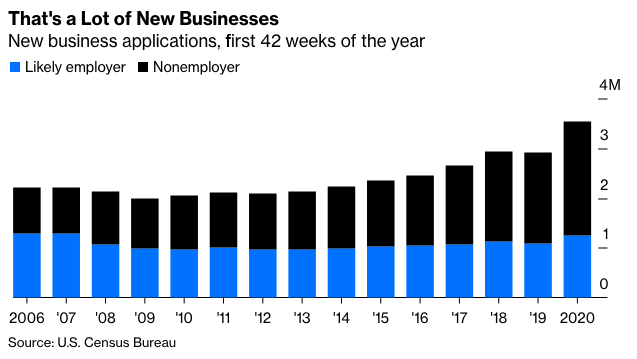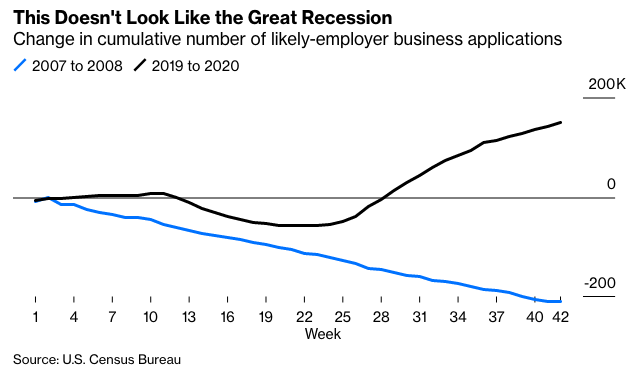Last week incorrigibly optimistic National Economic Council director Larry Kudlow said he detected “gales of creative destruction” blowing though the U.S. economy. The phrase, borrowed from the late Austrian-American economist Joseph Schumpeter, was perhaps an unfortunate choice of words for an aide to a president seeking reelection amid a pandemic-induced recession.
But the phenomenon Kudlow was commenting on — “the talk is that a lot of folks who became unemployed, alright, most regrettably, but they’re sticking with it and they’re going out and starting new businesses” — is for real. New businesses are being created this year at the fastest pace since 2006, which is how far back the Census Bureau’s weekly business formation statistics go.

These data are derived from applications to the Internal Revenue Service for new employer identification numbers. Most represent individuals striking out on their own, something that always happens when regular jobs are scarce, although previously not to quite this extent. But the Census Bureau also uses several filters to sort out new businesses with a high propensity to employ others, and those applications are on the rise, too — in stark contrast to what happened during the last recession.

“The Great Recession was too harsh for small businesses to be able to try new things,” says John Haltiwanger, an economics professor at the University of Maryland. “They couldn’t get loans, asset values were low.” This time around, thanks in part to massive early intervention by Congress and the Federal Reserve but also to the unconventional nature of the recession, stock prices and house prices are up and banks are healthy. Getting financing for a new business is far easier than it was a decade ago. And because of the huge changes in economic behavior brought on by the pandemic, a lot of people have ideas for new businesses.
Haltiwanger is one of a group of economists who a few years ago started producing research showing a decline in U.S. business dynamism. The number of startups has been falling since the 1990s, and so has the number of business failures. Schumpeter’s concept of creative destruction has been as prominent as ever in the rhetoric of business executives, but awfully hard to find in the data.
The Census Bureau started releasing business formation data as an outgrowth of this research, and for the past few months it has shown something new and different is afoot. It’s not something entirely positive: Equally timely and reliable data on business closures aren’t available, but a new paper by several Federal Reserve Board economists finds that “exit has been elevated at least among small firms and particularly in industries most sensitive to social distancing,” with restaurant closures in particular about 50% above the normal pace. But it is at least dynamic.
“There’s been this enormous shock to how we interact with each other, and it’s a positive sign there are lots of entrepreneurs out there trying to respond to that,” says Haltiwanger. “I don’t think this is like the ‘90s, where we saw a surge of startups because of the tech revolution — that came out of very positive forces. This happens sometimes as the economy gets hit by a shock that has aggregate consequences.”
This week the Census Bureau for the first time released data sorting the new-business numbers by industry. What it shows more than anything is entrepreneurs seeing opportunity in online retail.








